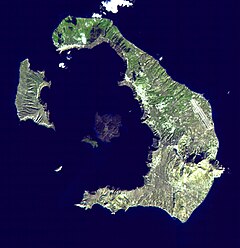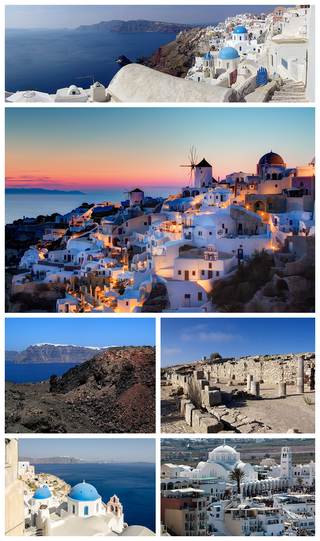
Santorini, officially Thira and Classical Greek Thera, is an island in the southern Aegean Sea, about 200 km (120 mi) southeast from the Greek mainland. It is the largest island of a small circular archipelago, which bears the same name and is the remnant of a caldera. It is the southernmost member of the Cyclades group of islands, with an area of approximately 73 km2 (28 sq mi) and a 2021 census population of 15,480. The municipality of Santorini includes the inhabited islands of Santorini and Therasia, as well as the uninhabited islands of Nea Kameni, Palaia Kameni, Aspronisi and Christiana. The total land area is 90.623 km2 (34.990 sq mi). Santorini is part of the Thira regional unit.

The 17th century BC was the century that lasted from 1700 BC to 1601 BC.
The 1620s BC was a decade lasting from January 1, 1629 BC to December 31, 1620 BC.

The Minoan civilization was a Bronze Age culture which was centered on the island of Crete. Known for its monumental architecture and energetic art, it is often regarded as the first civilization in Europe. The ruins of the Minoan palaces at Knossos and Phaistos are popular tourist attractions.

The majority of Egyptologists agree on the outline and many details of the chronology of Ancient Egypt. This scholarly consensus is known as the Conventional Egyptian chronology, which places the beginning of the Old Kingdom in the 27th century BC, the beginning of the Middle Kingdom in the 21st century BC and the beginning of the New Kingdom in the mid-16th century BC.

Laacher See, also known as Lake Laach or Laach Lake, is a volcanic caldera lake with a diameter of 2 km (1.2 mi) in Rhineland-Palatinate, Germany, about 24 km (15 mi) northwest of Koblenz, 37 km (23 mi) south of Bonn, and 8 km (5.0 mi) west of Andernach. It is in the Eifel mountain range, and is part of the East Eifel volcanic field within the larger Volcanic Eifel. The lake was formed by a Plinian eruption approximately 13,000 years BP with a Volcanic Explosivity Index (VEI) of 6, on the same scale as the Pinatubo eruption of 1991. The volcanic discharge observable as mofettas on the southeastern shore of the lake are signs of dormant volcanism.
The Tempest Stele was erected by pharaoh Ahmose I early in the 18th Dynasty of Egypt, c. 1550 BCE. The stele describes a great storm striking Egypt during this time, destroying tombs, temples and pyramids in the Theban region and the work of restoration ordered by the king.

Minoan chronology is a framework of dates used to divide the history of the Minoan civilization. Two systems of relative chronology are used for the Minoans. One is based on sequences of pottery styles, while the other is based on the architectural phases of the Minoan palaces. These systems are often used alongside one another.
Dense-rock equivalent (DRE) is a volcanologic calculation used to estimate volcanic eruption volume. One of the widely accepted measures of the size of a historic or prehistoric eruption is the volume of magma ejected as pumice and volcanic ash, known as tephra during an explosive phase of the eruption, or the volume of lava extruded during an effusive phase of a volcanic eruption. Eruption volumes are commonly expressed in cubic kilometers (km3).

Akrotiri is the site of a Cycladic Bronze Age settlement on the volcanic Greek island of Santorini (Thera). The name comes from the nearby village of Akrotiri.
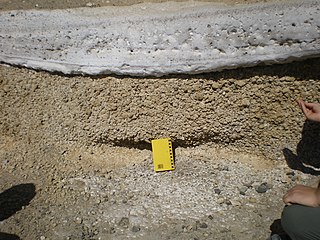
Phreatomagmatic eruptions are volcanic eruptions resulting from interaction between magma and water. They differ from exclusively magmatic eruptions and phreatic eruptions. Unlike phreatic eruptions, the products of phreatomagmatic eruptions contain juvenile (magmatic) clasts. It is common for a large explosive eruption to have magmatic and phreatomagmatic components.
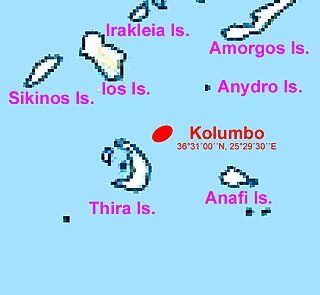
Kolumbo is an active submarine volcano in the Aegean Sea in Greece, about 8 km northeast of Cape Kolumbo, Santorini island. The largest of a line of about twenty submarine volcanic cones extending to the northeast from Santorini, it is about 3 km in diameter with a crater 1.5 km across. It first noticed by humans when it breached the sea surface in 1649-50. The Smithsonian Institution's Global Volcanism Program treats it as part of the Santorini volcano, though at least one source maintains that it is a separate magmatic system.

The Hatepe eruption, named for the Hatepe Plinian pumice tephra layer, sometimes referred to as the Taupō eruption or Horomatangi Reef Unit Y eruption, is dated to 232 CE ± 10 and was Taupō Volcano's most recent major eruption. It is thought to be New Zealand's largest eruption within the last 20,000 years. The eruption ejected some 45–105 km3 (11–25 cu mi) of bulk tephra, of which just over 30 km3 (7.2 cu mi) was ejected in approximately 6–7 minutes. This makes it one of the largest eruptions in the last 5,000 years, comparable to the Minoan eruption in the 2nd millennium BCE, the 946 eruption of Paektu Mountain, the 1257 eruption of Mount Samalas, and the 1815 eruption of Mount Tambora.
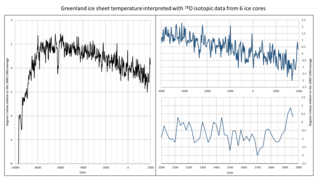
The Middle Bronze Age Cold Epoch was a period of unusually cold climate in the North Atlantic region that lasted about from 1800 BC to 1500 BC. It was followed by the Bronze Age Optimum.
Malcolm H. Wiener is an American attorney, prehistorian and philanthropist. Most notably, Wiener has served as general counsel of the Archaeological Institute of America, as an advisor for the United States Department of State and as principal and chairman of The Millburn Corporation and ShareInVest, both investment management firms.
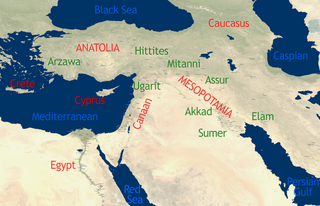
The chronology of the ancient Near East is a framework of dates for various events, rulers and dynasties. Historical inscriptions and texts customarily record events in terms of a succession of officials or rulers: "in the year X of king Y". Comparing many records pieces together a relative chronology relating dates in cities over a wide area.

Santorini caldera is a large, mostly submerged caldera, located in the southern Aegean Sea, 120 kilometers north of Crete in Greece. Visible above water is the circular Santorini island group, consisting of Santorini, the main island, Therasia and Aspronisi at the periphery, and the Kameni islands at the center. It has been designated a Decade Volcano.
Christopher Bronk Ramsey is a British physicist, mathematician and specialist in radiocarbon dating. He is a professor at the University of Oxford and was the Director of the Research Laboratory for Archaeology and the History of Art (RLAHA) from 2014 until 2019. He is a member of Merton College, Oxford and a Bodley Fellow. His doctorate, completed in 1987, included the first successful implementation of carbon dioxide gas as a target for radiocarbon dating via accelerator mass spectrometry.

The Akrotiri Boxer Fresco, discovered in 1967, is one of the Wall Paintings of Thera and a leading example of Minoan painting. It is a fresco depicting two young boys wearing boxing gloves and belts and dates back to the Bronze Age, 1700 BCE. Around 1600 BCE, a disastrous earthquake, followed by a volcanic eruption, covered Akrotiri, Greece in a thick layer of pumice and ash, which resulted in the remarkable conservation of frescoes, including the Akrotiri Boxer Fresco, from multiple buildings throughout the town. This particular fresco was found in room B1 of Building Beta along with the Antelope Fresco. The boys' shaved heads and stray locks indicate their youth, while their darker skin tone indicates their gender. The boy on the right is completely nude except for a belt, whereas the boy on the left has jewellery; most likely markers of a higher status. They appear to be slightly over life-size at roughly 5 ft 10 in (1.78 m). To create such vibrant frescoes, a smooth lime plaster was applied to the walls and then painted over. It is impossible to know whether the match was a competitive one or simply a routine sport.
